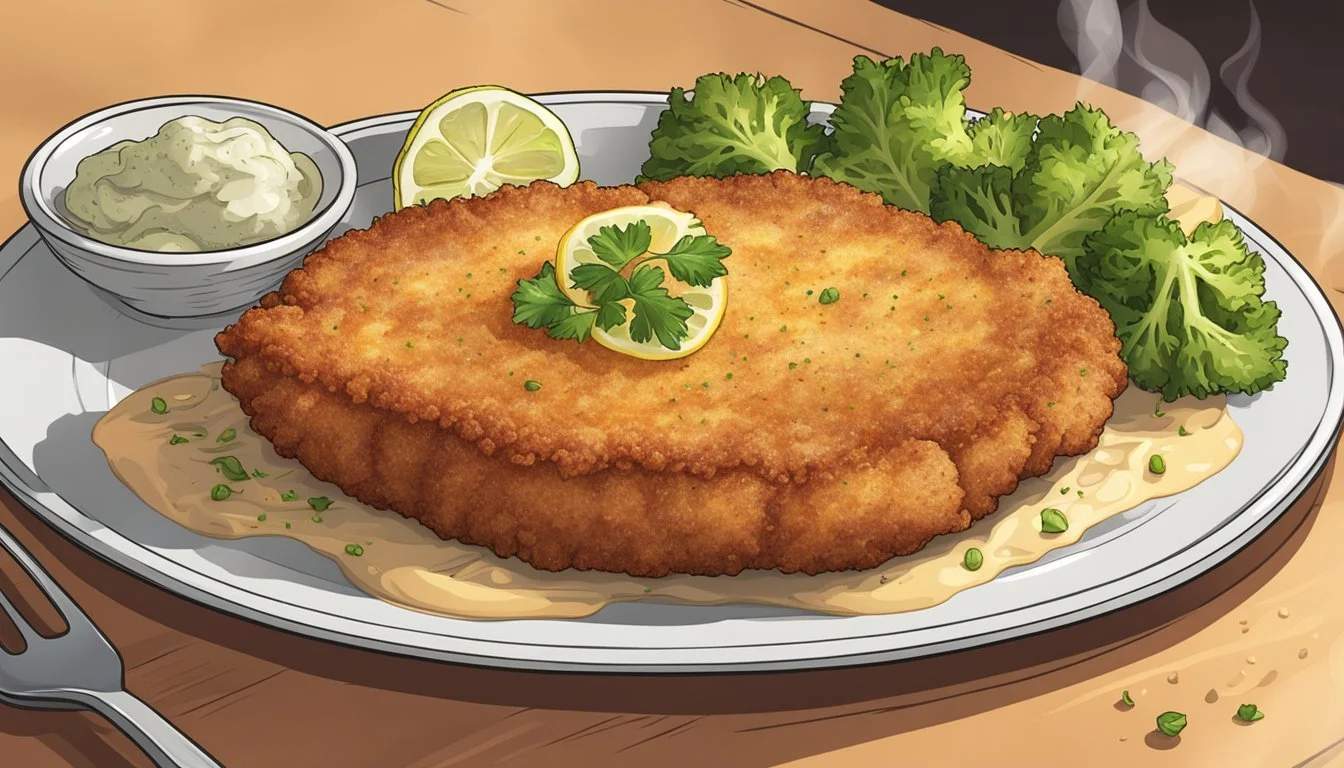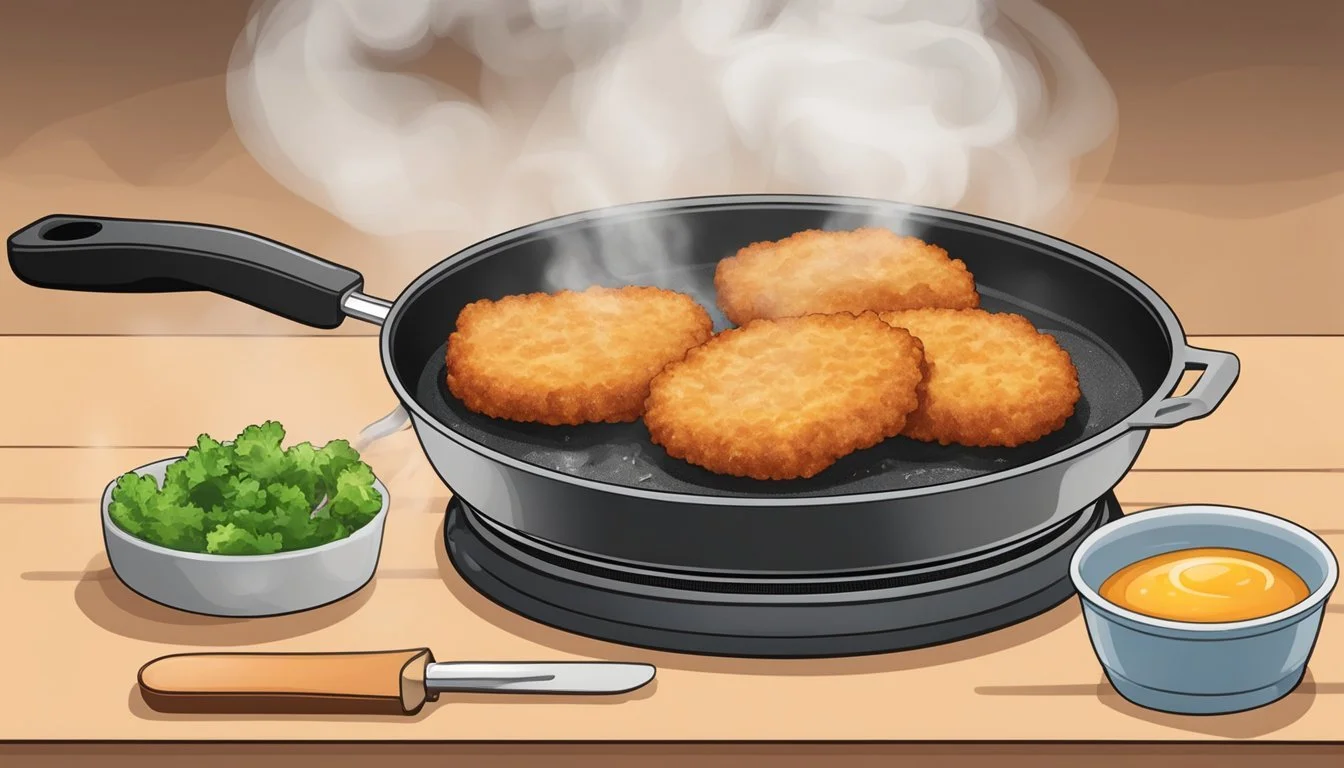Best Way to Reheat Pork Schnitzel
Ensuring a Crispy Crust and Juicy Interior
Pork schnitzel, with its inviting crispy crust enveloping succulent meat, is a favorite for many. Achieving that same delightful texture and taste on the second go-round can be a culinary challenge. When it comes to reheating pork schnitzel, the method chosen is crucial to ensure the cutlet doesn't lose its charm. Preservation of its crispy exterior while maintaining the juiciness of the meat is paramount for replicating the fresh-cooked appeal.
Reheating schnitzel in ways that respect the delicate balance of its components ensures the dish remains enjoyable even after refrigeration. Skillet warming, oven baking, and air frying are favored methods that can help in preserving crispiness. Each technique, when leveraged correctly, can breathe new life into leftover schnitzel without turning it into a soggy or dried-out dish. These methods are quick, efficient, and designed to maintain the integrity of this classic dish's well-loved texture and flavor.
Understanding Pork Schnitzel
Understanding the fundamentals of pork schnitzel, as well as the importance of maintaining its iconic crispy texture and juicy meat, is essential for perfecting the reheating process.
The Basics of Schnitzel
Pork schnitzel is a beloved dish that originated in Austria. It consists of a thin slice of meat, often pounded to tenderize, which is breaded and then fried until crispy. The meat used is typically from pork loin or tenderloin, which contributes to the juiciness and flavor that schnitzel enthusiasts crave. Achieving the right balance of a golden-brown crust with a tender interior is the hallmark of an authentic schnitzel.
Importance of Crispy Texture and Juicy Meat
The texture of pork schnitzel is a critical aspect of its appeal. The breading, when fried to perfection, forms a crispy exterior that provides a satisfying contrast to the juicy, tender pork within. The flavor of schnitzel is greatly reliant on this interplay between crust and meat—a symphony of crunch and savoriness in every bite. Reheating the schnitzel without compromising on this textural contrast is a key objective for any chef or home cook who values the integrity of the dish.
Preparing Leftover Schnitzel for Reheating
Properly storing and preparing leftover schnitzel for reheating is crucial to maintaining its crispiness and flavor. Attention to handling and pre-reheating techniques ensures the quality of the schnitzel is preserved.
Handling and Storage Tips
After enjoying a delicious schnitzel, prompt storage is key to ensuring it retains its quality for reheating. To properly store leftover schnitzel, they should follow these guidelines:
Cooling Down: Allow the schnitzel to cool to room temperature to prevent moisture build-up within the container.
Moisture Prevention: Wrap the schnitzel in paper towels to absorb any excess oil, which can help keep the crust crisp.
Airtight Containers: Place the schnitzel in an airtight container to protect it from absorbing any other flavors or odors from the refrigerator.
Refrigeration: Refrigerate the schnitzel promptly after it has cooled down. This will slow down bacterial growth and maintain freshness.
Pre-Reheating Considerations
Before one begins to reheat leftover schnitzel, they need to consider a few steps to ensure the best possible outcome:
Room Temperature Rest: Remove the schnitzel from the refrigerator and let it sit out for about 10-15 minutes to come to room temperature. This helps in even reheating.
Reseal the Moisture: If the schnitzel has dried out slightly in the fridge, they can lightly brush it with oil on both sides to help reseal in the moisture and prepare it for reheating.
By following these specific pre-reheating procedures, they can help ensure that the reheated schnitzel is as close to its original state as possible in terms of texture and taste.
Reheating Techniques Overview
Proper reheating methods can maintain the delightful crispy crust and juicy interior of a pork schnitzel. Each strategy has its own merits, tailored to suit different preferences and kitchen tools.
Oven Reheating Strategy
Using the oven to warm up pork schnitzel allows for an even distribution of heat, which can preserve the original texture. The schnitzel should be placed on a wire rack over a baking sheet and heated at 350°F for about 10 minutes. This method helps keep the crust crispy and the meat juicy without the use of additional oil.
Stovetop Reheating Method
The stovetop method involves lightly oiling a pan and reheating the schnitzel over medium heat. It usually takes about 2 minutes per side to get the schnitzel thoroughly warm and restore some of its crispiness. Care should be taken to avoid overheating as this can dry out the meat.
Air Fryer Reheating Tips
An air fryer provides a quick way to reheat the schnitzel while preserving its desirable crispness. The schnitzel should be heated at a moderate temperature for 3-4 minutes. This method circulates hot air around the food, minimizing the need for additional oil and ensuring a more uniform heat distribution.
Microwave Reheating Approach
While not ideal for maintaining crispness, the microwave can be a convenient option for reheating schnitzel. To avoid drying out the meat, reheat at 50% power in short intervals of 30 seconds, flipping the meat once. This method is best for those short on time and primarily looking for a warm meal rather than a crispy crust.
Step-by-Step Oven Reheating
Reheating pork schnitzel in the oven can restore its crispy crust while maintaining a juicy interior. To achieve optimal results, precision in temperature setting and preparation of the reheating surface is crucial.
Setting Up the Oven for Best Results
The oven should be preheated to a moderate temperature to ensure even reheating. Preheat your oven to 325°F (163°C), as higher temperatures might compromise the schnitzel's juiciness. This gradual reheating process allows the heat to penetrate through the schnitzel without burning the crust or drying out the meat.
Using Baking Sheet and Foil for Crispiness
The purpose of using a baking sheet is to provide a flat surface for even heat distribution. Place a piece of aluminum foil on the baking sheet to catch any drips and to facilitate easy cleanup. However, do not wrap the schnitzel in foil as this can steam the crust and reduce its crispiness. Instead, the schnitzel should be placed directly on the baking sheet and into the preheated oven.
Baking Time: Reheat the schnitzel for about 6 minutes on one side, then carefully flip it using a spatula to maintain the integrity of the crust. Continue to heat it for another 6 minutes on the other side. This timing should suffice for the schnitzel to become thoroughly heated without overcooking.
Final Check: Ensure the pork schnitzel has reheated to a safe internal temperature. This is best achieved by using a food thermometer, checking that the internal temperature has reached at least 165°F (74°C).
Using the baking sheet without foil covering the schnitzel allows it to regain its crispiness, while the controlled oven temperature ensures it remains juicy.
Perfecting the Stovetop Technique
To achieve a crispy crust and juicy meat when reheating pork schnitzel, one must master the stovetop technique, carefully selecting the right skillet and managing the heat to maintain the desired texture.
Choosing the Right Skillet
The choice of skillet plays a crucial role in the reheating process. A heavy-bottomed skillet is preferred to ensure even heat distribution. Cast iron or a non-stick pan is ideally suited for this task, as they retain heat well and prevent the schnitzel from sticking.
Cast Iron Skillet: Retains heat efficiently for consistent crisping.
Non-Stick Pan: Reduces the need for excessive oil and prevents sticking.
Managing Heat for Optimal Texture
The key to a crispy exterior and warm, juicy interior is balanced heat management. One should avoid high heat as it can burn the crust without properly warming the interior.
Medium Heat: Begin by setting the stove to medium heat.
Oil: Lightly oil the skillet to create a non-stick surface.
Testing Heat: Before adding the schnitzel, ensure the oil sizzles upon contact.
Reheating: Using tongs, place the schnitzel in the skillet, heating each side for approximately 2 minutes or until the crust is golden and crispy.
Heat Moderation: Monitor and adjust the temperature to prevent overheating.
Usage of Tongs: Employ tongs for gentle flipping, keeping the crust intact.
Air Fryer Method for Crispiness
The air fryer is renowned for its ability to reheat foods while maintaining a crispy texture, and it works exceptionally well for pork schnitzel, delivering golden brown results.
Preparing the Air Fryer
One begins by ensuring the air fryer is clean and preheated to the right temperature, which optimizes the cooking environment for the schnitzel. Typically, the air fryer should be set to 350°F. It is important to avoid overcrowding the air fryer basket; schnitzel pieces should be placed in a single layer with space around them to allow for ample air circulation.
Preheat: Set the air fryer to 350°F (175°C).
Basket arrangement: Place schnitzel in a single layer, leave space between pieces.
Achieving Golden Brown Perfection
The schnitzel should be monitored for color and texture, being flipped once during the reheating process to ensure an even golden brown crust. The total time will vary based on the schnitzel’s thickness, but one can anticipate a range of 5-7 minutes. Checking the crust's texture during the process helps avoid overcooking, keeping the meat juicy.
Cooking time: Approximately 5-7 minutes, depending on thickness.
Turning: Flip the schnitzel halfway through cooking.
End result: Schnitzel should be crisp and golden brown.
Microwave Reheating: Dos and Don'ts
When reheating pork schnitzel in a microwave, the primary goals are to maintain the crispy crust and to ensure the meat remains juicy without becoming soggy.
Avoiding Sogginess with Microwave
Heating pork schnitzel in a microwave often leads to a soggy crust if not done properly. To avoid this, never place the schnitzel directly on a plate without preparation. Instead, it's crucial to set the microwave power correctly:
Power Level: Use a medium power level, about 50% of the microwave's capacity, to gently warm the schnitzel without overheating it.
Heating Time: Short bursts of 30 seconds to 1 minute are preferable, checking the progress between intervals to prevent overheating.
Additionally, one can consider positioning the schnitzel atop a microwave-safe rack if available, to encourage airflow around the schnitzel, which can help in keeping the crust crisp.
Using Damp Paper Towel Technique
Using a damp paper towel can aid in maintaining the moisture of the meat without making it soggy. The correct approach is as follows:
Dampen a paper towel with water, wring it out so it's not dripping, then place it over the pork schnitzel.
Microwave-Safe Plate: Place the schnitzel on a microwave-safe plate before covering it with the damp paper towel; this helps to trap a small amount of steam and prevent the meat from drying out.
Duration: Heat for short intervals, checking periodically to ensure the schnitzel has reached the desired temperature without the crust becoming soft.
By paying attention to these details, one can use the microwave to warm up pork schnitzel while still preserving its desirable qualities.
Maintaining Juiciness While Reheating
When reheating pork schnitzel, preserving its juiciness is paramount. The process begins with a gentle warming phase that carefully brings the meat up to an optimal internal temperature. This ensures that the schnitzel remains moist and flavorful.
One should start by preheating the oven to a low temperature, around 250°F (121°C), which helps the pork schnitzel to warm evenly without further cooking it to dryness. It is beneficial to place the schnitzel on an oven-safe tray and to tent it loosely with aluminum foil. This faux seal helps maintain moisture, preventing sogginess while not compromising the crust's crispiness.
It is crucial to monitor the schnitzel's internal temperature with a meat thermometer, aiming for an internal temperature of 145°F (63°C), the point at which pork is safe to eat and at its juiciest. Once this temperature is achieved, remove the schnitzel from the oven promptly.
Here is a concise guide for maintaining juiciness:
Preheat the oven to 250°F (121°C).
Place the schnitzel on an oven-safe tray.
Create a moisture barrier by tenting with aluminum foil.
Use a meat thermometer to avoid overheating.
By adhering to these steps, one can ensure that the reheated pork schnitzel is as juicy as when it was first cooked, thus preserving both its texture and taste.
Safety and Internal Temperature
When reheating pork schnitzel, reaching and verifying the appropriate internal temperature is crucial to ensure both safety and quality. A meat thermometer is an indispensable tool for this process.
Using Meat Thermometers
A meat thermometer should be used to check the internal temperature of the pork schnitzel during the reheating process. Inserting the thermometer into the thickest part of the cutlet without touching the bone or the pan ensures an accurate reading. This eliminates the guesswork and makes it possible to assess whether the pork is safely heated through to the required temperature.
What Temperature to Aim For
For pork schnitzel, the target should be an internal temperature of 145°F (63°C). This is the minimum safe temperature as recommended by food safety guidelines to ensure all harmful bacteria are eradicated.
Refrigerated Pork Schnitzel: Should reach 145°F (63°C).
Frozen Pork Schnitzel: Should first be defrosted safely in the refrigerator and then brought to 145°F (63°C) when reheated.
By adhering to these guidelines, individuals can indulge in their pork schnitzel with the confidence that it is both safe and deliciously heated.
Additional Tips and Tricks
When reheating pork schnitzel, attention to detail can make the difference between a soggy crust and a crispy, golden delight. The judicious use of oils and cooking techniques can preserve the texture and flavor of pork schnitzel.
The Role of Cooking Sprays and Oils
Cooking Sprays and Oils: When using a skillet, a fine mist of cooking spray or a thin layer of vegetable oil can help reestablish the schnitzel's crispiness. Olive oil, while flavorful, may not always be ideal due to its lower smoke point which can alter the taste at higher cooking temperatures.
Preventing Overcrowding in the Pan
Avoid Overcrowding: Reheat schnitzels in batches if necessary to allow heat to circulate evenly. Overcrowding the pan leads to steam accumulation, which can soften the crust and affect the meat's juiciness.
Serving and Pairings
After reheating pork schnitzel to its optimal crispiness, it's time to pair it with sides and present it in a way that complements this cherished dish. The right accompaniments and presentation techniques can amplify the schnitzel's flavor and ensure a well-rounded meal.
Side Dishes for Pork Schnitzel
The ideal side dishes for pork schnitzel bolster the main course without overwhelming its savory flavor. A classic and frequently recommended accompaniment is potato salad. It balances the schnitzel's richness with its creamy and tangy taste, providing a contrast that enhances the overall meal.
Potato Salad: Creamy with a slight tang, typically involving cider vinegar or mustard
Cucumber Salad: Light and refreshing, dressed in dill and vinegar
Sauerkraut: Adds a tangy, pickled flavor that pairs well with the schnitzel's crust
Braised Red Cabbage: Sweet and sour profile with a tender texture
Spätzle: Soft egg noodles that soak up the meal's flavors
The objective is to create a harmonious meal with sides that complement, rather than compete with, the schnitzel.
Presentation and Serving Suggestions
Presentation plays an important role in elevating the enjoyment of any meal made, and pork schnitzel is no exception. Place the schnitzel on a warm plate and arrange the side dishes in a way that is visually appealing.
Lemon Wedges: Adding a bright touch and the option to infuse a citrusy zest
Parsley: A sprinkle of chopped parsley can add a fresh color and subtle flavor
Dill Sauce: Serve alongside or drizzle creamy dill sauce for added moisture and taste
It’s recommended to serve the schnitzel as the star of the plate, with side dishes either in separate serving bowls or neatly placed beside the main dish. This ensures that each element of the meal maintains its distinct flavor and texture.
Frequently Asked Questions
When it comes to reheating pork schnitzel, ensuring the dish retains its delicious crispy crust and juicy interior is a primary concern. This section addresses some common queries surrounding the reheating process.
Can I Reheat Pork Schnitzel Multiple Times?
Reheating pork schnitzel more than once is not advisable. Each reheating cycle can degrade the quality, potentially leading to a dry and less flavorful meat. For the best results, one should only reheat what can be consumed in one sitting.
Is Freezing Pork Schnitzel a Good Option?
Freezing pork schnitzel is a viable option for extending its shelf life. To maintain its texture and taste upon reheating:
Before freezing:
Cool the schnitzel completely.
Wrap it tightly to avoid freezer burn.
After freezing:
Thaw in the refrigerator.
Reheat using methods that will restore its crispiness, such as in an oven or on a skillet.






